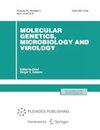Epstein-Barr病毒:gp350和EBNA2基因变异的评估
IF 0.3
4区 生物学
Q4 BIOCHEMISTRY & MOLECULAR BIOLOGY
引用次数: 1
摘要
世界上大约90%的人口感染了eb病毒(EBV)。对健康的损害和高昂的经济成本要求开发针对eb病毒的疫苗。个体基因的可变性可能影响疫苗接种运动的成功,并将需要动态更新疫苗的抗原组成。本研究的目的是评估从莫斯科州牙科诊所工作人员唾液中分离的EBV gp350和EBNA2基因的变异性。生物样本来自4家牙科诊所的105名雇员。对于EBV dna阳性样本,采用巢式PCR扩增EBNA2和gp350基因。测序时确定gp350基因的核苷酸序列。以B95-8菌株作为参考基因组,构建gp350蛋白n端片段的最大似然系统发育树。系统发育分析还包括NCBI数据库中的222份EBV样本。测定31份DNA样本的EBNA2基因型和gp350全基因序列。根据gp350蛋白的系统发育分析,俄罗斯病毒种群沿树均匀分布。同时,30份样本属于Aa支系(A, EBNA2基因A型;a, gp350序列与B95-8 [NC_007605.1]的相似性,1份样本属于Bb支(B, EBNA2基因型B;b, gp350与Jijoye的相似性[LN827800.1])。在30份俄罗斯Aa基因型样本中,发现22个个体谱和16个独特突变。在密切接触的工作人员中发现了相同的gp350配置文件。已确定的特征表明,需要对在俄罗斯收集的样本进行进一步的系统发育研究,以开发和引进疫苗并监测其效率。本文章由计算机程序翻译,如有差异,请以英文原文为准。
Epstein–Barr Virus: Evaluation of gp350 and EBNA2 Gene Variability
Abstract Approximately 90% of the world’s population is infected with the Epstein–Barr virus (EBV). Damage to health and high economical costs require the development of vaccines against EBV. The variability of individual genes may affect the success of the vaccination campaign and will necessitate dynamic update of antigenic composition of vaccines. The aim of this study was to assess the variability of EBV gp350 and EBNA2 genes isolated from saliva of dental clinic personnel in Moscow oblast. Biosamples were obtained from 105 employees at four dental clinics. For EBV DNA-positive samples, the EBNA2 and gp350 genes were amplified using nested PCR. The nucleotide sequence of gp350 gene was determined during sequencing. A maximum likelihood phylogenetic tree was constructed from the N-terminal fragment of gp350 protein, using B95-8 strain as a reference genome. Phylogenetic analysis also included 222 EBV samples from the NCBI database. The EBNA2 genotype and the whole gp350 gene sequence were determined for 31 DNA samples. Based on the phylogenetic analysis of gp350 protein, the Russian virus population was uniformly distributed along the tree. Meanwhile, 30 samples fell into the Aa clade (A, genotype A for EBNA2 gene; a, similarity of the gp350 sequence with B95-8 [NC_007605.1]) and one sample belonged to the Bb clade (B, genotype B for EBNA2 ; b , similarity of gp350 with Jijoye [LN827800.1]). For 30 Russian samples of Aa genotype, 22 individual profiles and 16 unique mutations were found. Identical gp350 profiles were found amongst staff working in close professional contact. The identified features indicated the need for further phylogenetic studies of samples collected in Russia to develop and introduce vaccines and monitor their efficiency.
求助全文
通过发布文献求助,成功后即可免费获取论文全文。
去求助
来源期刊

Molecular Genetics, Microbiology and Virology
BIOCHEMISTRY & MOLECULAR BIOLOGY-MICROBIOLOGY
CiteScore
0.70
自引率
0.00%
发文量
8
审稿时长
>12 weeks
期刊介绍:
Molecular Genetics, Microbiology and Virology is a journal that covers most topical theoretical and applied problems of molecular genetics of pro- and eukaryotic organisms, molecular microbiology and molecular virology. An important part the journal assigns to investigations of the genetic apparatus of microorganisms, searching for forms of genetic exchange, genetic mapping of pathogenic causative agents, to ascertainment of the structure and functions of extrachromosomal factors of heredity and migratory genetic elements, to theoretical studies into the mechanisms of genetic regulation. The journal publishes results of research on molecular and genetic bases of an eukaryotic cell, functioning of chromosomes and chromatin, nature of genetic changes in malignization and a set of hereditary diseases. On the pages of the journal there is covered the formulation of molecular bases of virology including issues of integration of viral and cellular genomes, and issues of persistence. The journal plans to put materials on genetic engineering, envisaging synthesis and isolation of genes from natural reservoirs, creation of plasmid- and virus-based vector, production of recombinant DNA molecules, the creation of Gene Banks for Microbes, animals, and human; and also on biotechnological production of hormones, components of antiviral vaccines, diagnostic and therapeutic preparations.
 求助内容:
求助内容: 应助结果提醒方式:
应助结果提醒方式:


